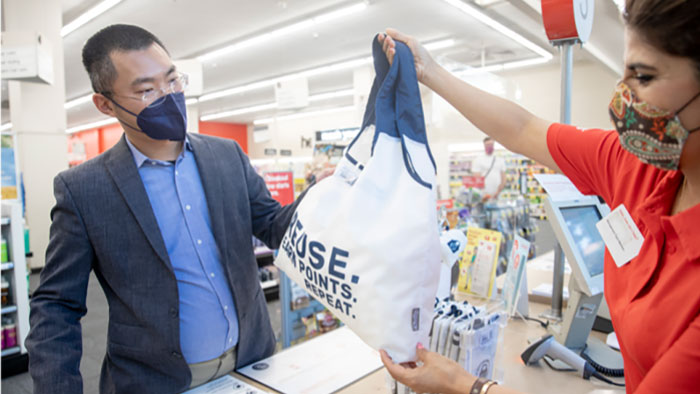Packaging Sustainability: Retail State of Play
- By [ Katie Nicholos , Kaela Martins ]
- 06/15/2021

Recently there has been a notable push on the supply chain side to reduce packaging throughout the transportation process as well as to reduce materials in some consumer packages. But aside from a few growing applications in tertiary packaging, few fully reusable packaging models are widely scaled in the US. RILA’s recent programming around reusable packaging and business models helps shine a light on where progress is being made and where the challenges persist.
This blog aims to give a brief overview of the playing field, bright spots within the industry, and a jumping off point for deeper company research.
1. Upstream Innovation – Packaging Solutions
The Ellen MacArthur Foundation (EMF) recently hosted a webinar with RILA’s Retail Compliance Center (RCC), giving an overview of their Upstream Innovation guide to packaging solutions. In this webinar, EMF shared practical solutions to achieve a more circular economy for plastics packaging, including the typical hurdles and opportunities associated with reuse models. To approach upstream innovation, businesses need to analyze their packaging, the product, and the current business model to conceptualize the most appropriate circular model. This can be achieved through elimination of excess packaging, implementation of reusable packaging models, or material circulation of packaging made from recycled materials.
To dig into the details of how to approach your upstream innovation, we recommend you revisit the webinar and slide deck here. You can also reference EMF’s Upstream Innovation Guide here.
2. Implementation of Reusable Packaging Models: Lessons Learned from the Field
Closed Loop Partners (CLP), joined by CVS Health, hosted a webinar with RILA’s RCC to share a lay of the land for reuse models in North America, including notable policy shifts, and highlighting sector innovators who are working to get reusable packaging off the ground. According to CLP, the four driving forces of reuse include environmental impact, regulation, innovation, and consumer demand. CLP organizes both the NextGen Consortium helping to accelerate the circular future of foodservice packaging and the Beyond the Bag Challenge exploring how to transport goods from retailer to destination in a way that is compatible with diver retail systems, delivers ease and convenience for customers, and reduces environmental impact. In each case, these initiatives are executed in partnership with a variety of organizations including retailers that help raise awareness, as well as convene innovative solutions to packaging challenges. Retailers should keep in mind these six key factors when they look to implement a reusable packaging model: location, payment model, health & safety protocols, impact and success metrics, and the engagement of diverse stakeholders.
To unpack all the insights provided by CLP and CVS Health, view the webinar and slide deck here. You can learn more about Closed Loop Partners here.
3. Use Cases Worth Highlighting
Innovation and packaging circularity go hand in hand. Here are just some of the creative companies looking to solve challenges in the market:
-
Algramo – A self-service smart dispensing system that is cash-less and touch-less and allows customers to buy only as much cleaning product as they need, when they need it. Algramo is currently available in Brooklyn, NY. Check them out: algramo.us.
-
MIWA – A circular system of reusable capsules that utilizes smart technology to meet today’s logistics and hygienic standards of today’s supermarket chains. MIWA aims to make waste-free shopping a “new-normal” for customers. MIWA is based in the Czech Republic, but may soon be available in the US (United States), look them up here: miwa.eu.
-
Replenish – A fully customizable packaging platform for liquid concentrates, Replenish wants to eliminate the waste of buying products in disposable plastic bottles. Their model creates pods of concentrate that can easily connect to a reusable bottle filled with tap water. See how you can join the mission here: myreplenish.com.
-
Waitrose & Partners Unpacked Pilot – A unique way of shopping that eliminates most packaging. The pilot is designed to test how future customers may shop, including refillable zones and frozen pick and mix stations. The pilot is currently active in select locations in the United Kingdom, but you can learn more about the program here: waitrose.com/ecom/shop/featured/groceries/unpacked.
-
Loop – A new way to shop without waste. Loop is currently available in the US with partnering companies Walgreens and Kroger. Loop offers customers the opportunity to place a refundable deposit to borrow the packaging, which is professionally cleaned and reused once returned through their waste-free delivery system. See how it works here: https://loopstore.com/how-it-works.
For continued reading on topics like these, be sure to visit RILA’s Retail Innovation Center where you can browse our Insight’s on-demand and Startup Network. RILA’s Retail Compliance Center is another great resource for training materials, regulatory tools, and more.
Want to learn more about RILA’s work in this area? Reach out to Katie Nicholos, senior manager of innovation at RILA’s Retail Innovation Center or Kaela Martins, manager of environmental programs at RILA’s Retail Compliance Center.
Tags
-
Climate and Sustainability
-
Ensuring a Safe, Sustainable Future
-
Technology & Innovation
-
Retail Innovation Center
-
Retail Works for All of Us
-
Supporting Free Markets and Fostering Innovation
-
Retail Compliance Center


